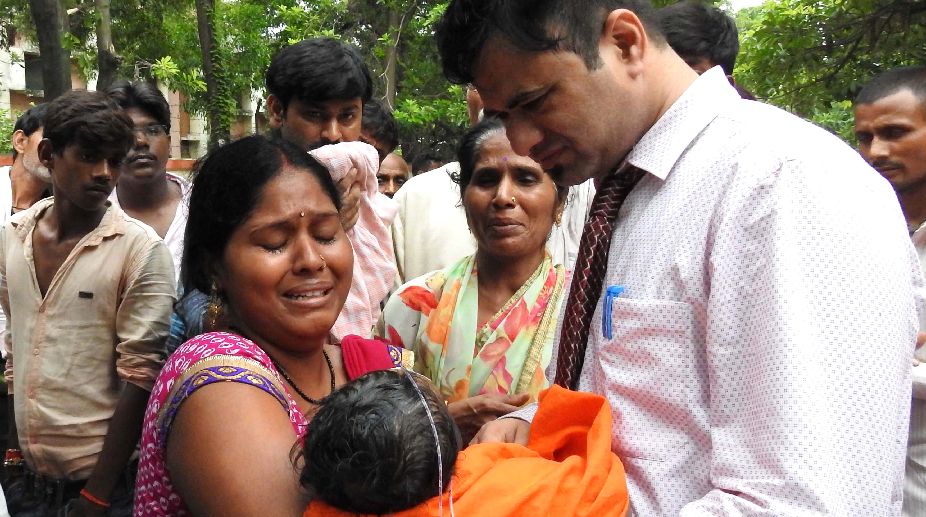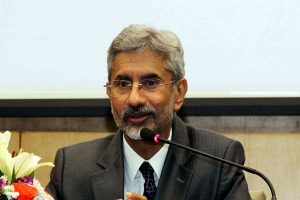As India was set to commemorate its 70th Independence Day with all nationalistic and fervour, the tragedy at BRD Medical College and Hospital, Gorakhpur where 63 children died in just five days shook the conscience of the nation.
It proved to be yet another gruesome example of ailing public healthcare system in India. An RTI enquiry disclosed 668 deaths (2015) in the paediatric section of the hospital alone and an appalling death rate of 17 to 18 per day in the last three years.
Advertisement
The Department of Paediatrics alone reported 3,745 deaths during 2009-2011. Though these disasters are common in our hospitals, some of the hospitals have accomplished notoriety for such tragedies in the recent past viz. 35 children died in B C Roy Children hospital in Kolkata, 40 infants died in SVPPG Institute of Paediatrics (Sishubhawan) Cuttack and so on.
Brutal death of children exposes serious flaw in India’s health care system. Lack of proper paediatric care facilities, unwillingness to face emergency situations, inability to stop the useless procedures and shortage of medical facilities and staff are contributing factors.
Policy makers often see the problem as a critical demand-supply mismatch in a hugely underfunded sector. On the other hand, nine of India’s poorest states (called focussed states in policy parlance i.e. Bihar, Chhattisgarh, Jharkhand, Madhya Pradesh, Odisha, Rajasthan, Uttarakhand, Uttar Pradesh and Assam) – are home to 581 million or 48 per cent of India’s population – accounting for 70 per cent of the country’s infant deaths. This includes 75 per cent of under-five deaths and 62 per cent of maternal deaths.
Surprisingly these states regularly fail to utilise the money earmarked for healthcare, which is lamented in India Spend analysis of 2017(Reserve Bank of India data on state budgets). The instant issue goes far beyond politics and our public discourse. Even if it is accepted that viral infection may have caused encephalitis, but so many other attributable factors could have made the deaths avoidable.
Lack of cleanliness, swampy environment which creates conducive atmosphere for the growth of bacterial, fungal, parasitic, viral agents and inadequacy or ill- preparedness for the emergency situation are some of the major reasons for such tragedies. India has a pathetic record of infant mortality though there is a slight improvement i.e. from 57 to 41 (per 1,000 live births) in the last decade.
The public health expenditure has slightly gone upward to 1.4 per cent of the GDP which is one of the lowest among the developing nations. The political discourse as to who is responsible for the UP tragedy or who is not, cannot hijack the fact that our health care facilities are in crisis. In so far as the public spending on healthcare is concerned, we are abysmally low.
A research by medical journal Lancet reveals that India ranked 154 out of 195 countries in terms of healthcare access, far behind countries like Bangladesh, Nepal, Ghana and Liberia. According to the World Bank, the per capita healthcare expenditure in India has been stagnating at around $60 for the past decade whereas countries like Brazil ($1000) or China ($300) are far ahead.
Healthcare has never been the top priority for successive Governments since independence until 1982-83, when for the first time a National Health Policy was endorsed. The said policy mostly focussed on preventive health care rather than curative health care services. Though the focus and direction of the Policy has undergone substantial change over time, we are still facing a skewed doctor-patient ratio of 1:1674 against the WHO norm of 1:1000.
The rural health care system is struggling with a deeper crisis. Though the heart of India resides in 6,40,867 villages, the health care scenario is riddled with lack of resources – human or otherwise. This sector throws a pathetic and shameful figure – 50 per cent of all villagers have no access to healthcare facilities, 10 per cent of all babies die before their first birthday. In this backdrop, our policy goals need to chase plethora of issues afflicting this sector.
Women, as a consumer of health care services, are important stakeholders in India’s healthcare system. About 12 million girls were aborted in the last three decades in India, 45 per cent Indian women are married before they turn 18 resulting in early pregnancies, higher morbidity and mortality rates. A mother dies every ten minutes in India., about 1.25 million children die annually in India, 48 per cent of all children have stunted growth due to malnutrition. (Source: Lancet 2011 and Save the Children)
Medical insurance has the potentiality to alter the entire health care landscape of India but only 243 million out of 1.2 billion citizens are covered under health insurance schemes. (Source: Planning Commission Report for the 12th Five Year Plan). Most of our healthcare woes could be ameliorated if the concerned stake holders work in tandem. Public health systems seem to suffer from a trust and perception deficit because they are overburdened, understaffed, and underfunded.
It’s a travesty that 70 years after independence, our children are meeting their tragic ends due to our irresponsible health care system with huge barriers on the way to health care facilities. The stunted policy implementation, apathetic attitude of the Government and minimal public discourse on this issue are ensuring that incidents such as at Gorakhpur occur with frightening regularity.
A successful democracy does not mean symbolic election; it does mandate raising the quality of life of the population though improvement in health, education, employment and other ancillary aspects. This is also mandated by the Right to Life as guaranteed by the Constitution. There is an urgent need to redefine Policy choices of partnering with the private sector, as emphasised by the Niti Ayog, to address the problems with a holistic approach.
The National Health Policy 2017, which promises to increase public health spending to 2.5 per cent of GDP has to safeguard the health care services to all Indian citizens, particularly the underprivileged. At the same time, it will have to stop the rise of exploitative private health sector that is already in the radar of global business corporations.
(The writers are, respectively, Advocate, Supreme Court of India and Associate Professor of Law at NLU Odisha. The views expressed are personal)











